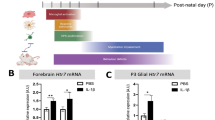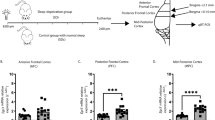Abstract
It has become increasingly evident the serotonergic (5-hydroxytryptamine, 5-HT) system is an important central neuronal network disrupted following neonatal hypoxic–ischemic (HI) insults. Serotonin acts via a variety of receptor subtypes that are differentially associated with behavioural and cognitive mechanisms. The 5-HT7 receptor is purported to play a key role in epilepsy, anxiety, learning and memory and neuropsychiatric disorders. Furthermore, the 5-HT7 receptor is highly localized in brain regions damaged following neonatal HI insults. Utilising our well-established neonatal HI model in the postnatal day 3 (P3) rat pup we demonstrated a significant decrease in levels of the 5-HT7 protein in the frontal cortex, thalamus and brainstem one week after insult. We also observed a relative decrease in both the cytosolic and membrane fractions of 5-HT7. The 5-HT7 receptor was detected on neurons throughout the cortex and thalamus, and 5-HT cell bodies in the brainstem. However we found no evidence of 5-HT7 co-localisation on microglia or astrocytes. Moreover, minocycline treatment did not significantly prevent the HI-induced reductions in 5-HT7. In conclusion, neonatal HI injury caused significant disruption to 5-HT7 receptors in the forebrain and brainstem. Yet the use of minocycline to inhibit activated microglia, did not prevent the HI-induced changes in 5-HT7 expression.




Similar content being viewed by others
References
Reinebrant HE, Wixey JA, Gobe GC, Colditz PB, Buller KM (2010) Differential effects of neonatal hypoxic-ischemic brain injury on brainstem serotonergic raphe nuclei. Brain Res 1322C:124–133. https://doi.org/10.1016/j.brainres.2010.01.065
Wixey JA, Reinebrant HE, Buller KM (2011) Inhibition of neuroinflammation prevents injury to the serotonergic network after hypoxia-ischemia in the immature rat brain. J Neuropathol Exp Neurol 70(1):23–35
Wixey JA, Reinebrant HE, Buller KM (2012) Post-insult ibuprofen treatment attenuates damage to the serotonergic system after hypoxia-ischemia in the immature rat brain. J Neuropathol Exp Neurol 71(12):1137–1148. https://doi.org/10.1097/NEN.0b013e318277d4c7
Reinebrant HE, Wixey JA, Buller KM (2012) Disruption of raphe serotonergic neural projections to the cortex: a potential pathway contributing to remote loss of brainstem neurons following neonatal hypoxic-ischemic brain injury. Eur J Neurosci 36(11):3483–3491. https://doi.org/10.1111/j.1460-9568.2012.08276.x
Bellot B, Peyronnet-Roux J, Gire C, Simeoni U, Vinay L, Viemari JC (2014) Deficits of brainstem and spinal cord functions after neonatal hypoxia-ischemia in mice. Pediatr Res 75(6):723–730. https://doi.org/10.1038/pr.2014.42
Drobyshevsky A, Takada SH, Luo K, Derrick M, Yu L, Quinlan KA, Vasquez-Vivar J, Nogueira MI, Tan S (2015) Elevated spinal monoamine neurotransmitters after antenatal hypoxia-ischemia in rabbit cerebral palsy model. J Neurochem 132(4):394–402. https://doi.org/10.1111/jnc.12997
Wixey JA, Reinebrant HE, Spencer SJ, Buller KM (2011) Efficacy of post-insult minocycline administration to alter long-term hypoxia-ischemia-induced damage to the serotonergic system in the immature rat brain. Neuroscience 182:184–192. https://doi.org/10.1016/j.neuroscience.2011.03.033
Dahlqvist P, Ronnback A, Risedal A, Nergardh R, Johansson IM, Seckl JR, Johansson BB, Olsson T (2003) Effects of postischemic environment on transcription factor and serotonin receptor expression after permanent focal cortical ischemia in rats. Neuroscience 119(3):643–652
Cook EH, Leventhal BL (1996) The serotonin system in autism. Curr Opin Pediatr 8(4):348–354
Lassig JP, Vachirasomtoon K, Hartzell K, Leventhal M, Courchesne E, Courchesne R, Lord C, Leventhal BL, Cook EH Jr (1999) Physical mapping of the serotonin 5-HT(7)receptor gene (HTR7) to chromosome 10 and pseudogene (HTR7P) to chromosome 12, and testing of linkage disequilibrium between HTR7 and autistic disorder. Am J Med Genet 88(5):472–475
Hedlund PB, Sutcliffe JG (2007) The 5-HT7 receptor influences stereotypic behavior in a model of obsessive-compulsive disorder. Neurosci Lett 414(3):247–251. https://doi.org/10.1016/j.neulet.2006.12.054
Sarkisyan G, Hedlund PB (2009) The 5-HT7 receptor is involved in allocentric spatial memory information processing. Behav Brain Res 202(1):26–31. https://doi.org/10.1016/j.bbr.2009.03.011
Leopoldo M, Lacivita E, Berardi F, Perrone R, Hedlund PB (2011) Serotonin 5-HT7 receptor agents: structure-activity relationships and potential therapeutic applications in central nervous system disorders. Pharmacol Ther 129(2):120–148. https://doi.org/10.1016/j.pharmthera.2010.08.013
Ciranna L, Catania MV (2014) 5-HT7 receptors as modulators of neuronal excitability, synaptic transmission and plasticity: physiological role and possible implications in autism spectrum disorders. Front Cell Neurosci 8:250. https://doi.org/10.3389/fncel.2014.00250
Dixon BJ, Reis C, Ho WM, Tang J, Zhang JH (2015) Neuroprotective strategies after neonatal hypoxic ischemic encephalopathy. Int J Mol Sci 16(9):22368–22401. https://doi.org/10.3390/ijms160922368
Neumaier JF, Sexton TJ, Yracheta J, Diaz AM, Brownfield M (2001) Localization of 5-HT(7) receptors in rat brain by immunocytochemistry, in situ hybridization, and agonist stimulated cFos expression. J Chem Neuroanat 21(1):63–73
Gustafson EL, Durkin MM, Bard JA, Zgombick J, Branchek TA (1996) A receptor autoradiographic and in situ hybridization analysis of the distribution of the 5-ht7 receptor in rat brain. Br J Pharmacol 117(4):657–666
To ZP, Bonhaus DW, Eglen RM, Jakeman LB (1995) Characterization and distribution of putative 5-ht7 receptors in guinea-pig brain. Br J Pharmacol 115(1):107–116
Chapin EM, Andrade R (2001) A 5-HT(7) receptor-mediated depolarization in the anterodorsal thalamus. II. Involvement of the hyperpolarization-activated current I(h). J Pharmacol Exp Ther 297(1):403–409
Goaillard JM, Vincent P (2002) Serotonin suppresses the slow afterhyperpolarization in rat intralaminar and midline thalamic neurones by activating 5-HT(7) receptors. J Physiol 541(Pt 2):453–465
Shimizu M, Nishida A, Zensho H, Yamawaki S (1996) Chronic antidepressant exposure enhances 5-hydroxytryptamine7 receptor-mediated cyclic adenosine monophosphate accumulation in rat frontocortical astrocytes. J Pharmacol Exp Ther 279(3):1551–1558
Hirst WD, Price GW, Rattray M, Wilkin GP (1997) Identification of 5-hydroxytryptamine receptors positively coupled to adenylyl cyclase in rat cultured astrocytes. Br J Pharmacol 120(3):509–515. https://doi.org/10.1038/sj.bjp.0700921
Cohen Z, Bouchelet I, Olivier A, Villemure JG, Ball R, Stanimirovic DB, Hamel E (1999) Multiple microvascular and astroglial 5-hydroxytryptamine receptor subtypes in human brain: molecular and pharmacologic characterization. J Cereb Blood Flow Metab 19(8):908–917. https://doi.org/10.1097/00004647-199908000-00010
Lieb K, Biersack L, Waschbisch A, Orlikowski S, Akundi RS, Candelario-Jalil E, Hull M, Fiebich BL (2005) Serotonin via 5-HT7 receptors activates p38 mitogen-activated protein kinase and protein kinase C epsilon resulting in interleukin-6 synthesis in human U373 MG astrocytoma cells. J Neurochem 93(3):549–559. https://doi.org/10.1111/j.1471-4159.2005.03079.x
Mahe C, Loetscher E, Dev KK, Bobirnac I, Otten U, Schoeffter P (2005) Serotonin 5-HT7 receptors coupled to induction of interleukin-6 in human microglial MC-3 cells. Neuropharmacology 49(1):40–47. https://doi.org/10.1016/j.neuropharm.2005.01.025
Hagberg H, Gilliaud E, Bona E (1996) Enhanced expression of IL1 and IL6 mRNA and bioactive proteins after hypoxia ischemia in neonatal rats. Ped Res 40:603–609
McRae A, Gilland E, Bona E, Hagberg H (1995) Microglia activation after neonatal hypoxic-ischemia. Dev Br Res 84:245–252
Bona E, Andersson AL, Blomgren K, Gilland E, Puka-Sundvall M, Gustafson K, Hagberg H (1999) Chemokine and inflammatory cell response to hypoxia ischemia in immature rats. Ped Res 45:500–509
Cai Z, Pang Y, Xiao F, Rhodes PG (2001) Chronic ischemia preferentially causes white matter injury in the neonatal rat brain. Brain Res 898:126–135
Fox CK, Dingman A, Derugin N, Wendland MF, Manabat C, Ji S, Ferriero DM, Vexler ZS (2005) Minocycline confers early but transient protection in the immature brain following focal cerebral ischemia-reperfusion. J Cereb Blood Flow Metab 25(9):1140–1151
Cai Z, Lin S, Fan L-W, Pang Y, Rhodes PG (2006) Minocycline alleviates hypoxic-ischemic injury to developing oligodendrocytes in the neonatal rat brain. Neuroscience 137(2):425–435
Robinson S, Petelenz K, Li Q, Cohen ML, DeChant A, Tabrizi N, Bucek M, Lust D, Miller RH (2005) Developmental changes induced by graded prenatal systemic hypoxic-ischemic insults in rats. Neurobiol Dis 18(3):568–581
Fan L-W, Lin S, Pang Y, Rhodes PG, Cai Z (2006) Minocycline attenuates hypoxia-ischemia-induced neurological dysfunction and brain injury in the juvenile rat. Eur J Neurosci 24:341–350
Sizonenko SV, Kiss JZ, Inder TE, Gluckman PD, Williams CE (2005) Distinctive neuropathologic alterations in the deep layers of the parietal cortex after moderate ischemic-hypoxic injury in the P3 immature rat brain. Pediatr Res 57:865–872
Leonardo CC, Eakin AK, Ajmo JM, Collier LA, Pennypacker KR, Strongin AY, Gottschall PE (2008) Delayed administration of a matrix metalloproteinase inhibitor limits progressive brain injury after hypoxia-ischemia in the neonatal rat. J Neuroinflammation 5:34. https://doi.org/10.1186/1742-2094-5-34
Jantzie LL, Todd KG (2010) Doxycycline inhibits proinflammatory cytokines but not acute cerebral cytogenesis after hypoxia-ischemia in neonatal rats. J Psychiatry Neurosci 35(1):20–32
Nijboer CH, Heijnen CJ, Groenendaal F, van Bel F, Kavelaars A (2009) Alternate pathways preserve tumor necrosis factor-alpha production after nuclear factor-kappaB inhibition in neonatal cerebral hypoxia-ischemia. Stroke 40(10):3362–3368. https://doi.org/10.1161/STROKEAHA.109.560250
Buller KM, Wixey JA, Pathipati P, Carty M, Colditz PB, Williams CE, Scheepens A (2008) Selective losses of brainstem catecholamine neurons after hypoxia-ischemia in the immature rat pup. Ped Res 63:364–369
Paxinos G, Watson C (1997) The rat brain in stereotaxic coordinates. Academic Press, San Diego
Wixey JA, Reinebrant HE, Buller KM (2012) Evidence that the serotonin transporter does not shift into the cytosol of remaining neurons after neonatal brain injury. Neurosci Res 73(3):252–256. https://doi.org/10.1016/j.neures.2012.04.002
Laemmli UK (1970) Cleavage of structural proteins during the assembly of the head of bacteriophage T4. Nature 227(5259):680–685
Wixey JA, Reinebrant HE, Carty ML, Buller KM (2009) Delayed P2 × 4R expression after hypoxia-ischemia is associated with microglia in the immature rat brain. J Neuroimmunol 212(1–2):35–43. https://doi.org/10.1016/j.jneuroim.2009.04.016
Carty ML, Wixey JA, Colditz PB, Buller KM (2008) Post-hypoxia-ischemia minocycline treatment attenuates neuroinflammation and white matter injury in the neonatal rat; a comparison of two different dose regimens. Int J Dev Neurosci 26:477–485
Reinebrant HE, Wixey JA, Buller KM (2013) Neonatal hypoxia-ischaemia disrupts descending neural inputs to dorsal raphe nuclei. Neuroscience 248:427–435. https://doi.org/10.1016/j.neuroscience.2013.06.016
Kobe F, Guseva D, Jensen TP, Wirth A, Renner U, Hess D, Muller M, Medrihan L, Zhang W, Zhang M, Braun K, Westerholz S, Herzog A, Radyushkin K, El-Kordi A, Ehrenreich H, Richter DW, Rusakov DA, Ponimaskin E (2012) 5-HT7R/G12 signaling regulates neuronal morphology and function in an age-dependent manner. J Neurosci 32(9):2915–2930. https://doi.org/10.1523/JNEUROSCI.2765-11.2012
Russo A, Pellitteri R, Monaco S, Romeo R, Stanzani S (2005) “In vitro” postnatal expression of 5-HT7 receptors in the rat hypothalamus: an immunohistochemical analysis. Brain Res Dev Brain Res 154(2):211–216. https://doi.org/10.1016/j.devbrainres.2004.11.002
Chugani DC, Muzik O, Rothermel R, Behen M, Chakraborty P, Mangner T, da Silva EA, Chugani HT (1997) Altered serotonin synthesis in the dentatothalamocortical pathway in autistic boys. Ann Neurol 42(4):666–669. https://doi.org/10.1002/ana.410420420
Costa L, Spatuzza M, D’Antoni S, Bonaccorso CM, Trovato C, Musumeci SA, Leopoldo M, Lacivita E, Catania MV, Ciranna L (2012) Activation of 5-HT7 serotonin receptors reverses metabotropic glutamate receptor-mediated synaptic plasticity in wild-type and Fmr1 knockout mice, a model of Fragile X syndrome. Biol Psychiatry 72(11):924–933. https://doi.org/10.1016/j.biopsych.2012.06.008
Guthrie CR, Murray AT, Franklin AA, Hamblin MW (2005) Differential agonist-mediated internalization of the human 5-hydroxytryptamine 7 receptor isoforms. J Pharmacol Exp Ther 313(3):1003–1010. https://doi.org/10.1124/jpet.104.081919
Dixon RM, Mellor JR, Hanley JG (2009) PICK1-mediated glutamate receptor subunit 2 (GluR2) trafficking contributes to cell death in oxygen/glucose-deprived hippocampal neurons. J Biol Chem 284(21):14230–14235. https://doi.org/10.1074/jbc.M901203200
Sato M, Jiao Q, Honda T, Kurotani R, Toyota E, Okumura S, Takeya T, Minamisawa S, Lanier SM, Ishikawa Y (2009) Activator of G protein signaling 8 (AGS8) is required for hypoxia-induced apoptosis of cardiomyocytes: role of G betagamma and connexin 43 (CX43). J Biol Chem 284(45):31431–31440. https://doi.org/10.1074/jbc.M109.014068
De Martelaere K, Lintermans B, Haegeman G, Vanhoenacker P (2007) Novel interaction between the human 5-HT7 receptor isoforms and PLAC-24/eIF3k. Cell Signal 19(2):278–288. https://doi.org/10.1016/j.cellsig.2006.06.012
Smith C, Rahman T, Toohey N, Mazurkiewicz J, Herrick-Davis K, Teitler M (2006) Risperidone irreversibly binds to and inactivates the h5-HT7 serotonin receptor. Mol Pharmacol 70(4):1264–1270. https://doi.org/10.1124/mol.106.024612
Buller KM, Wixey JA, Reinebrant HE (2012) Disruption of the serotonergic system after neonatal hypoxia-ischemia in a rodent model. Neurol Res Int. https://doi.org/10.1155/2012/650382
Buller KM, Carty ML, Reinebrant HE, Wixey JA (2009) Minocycline: a neuroprotective agent for hypoxic-ischemic brain injury in the neonate? J Neurosci Res 87(3):599–608. https://doi.org/10.1002/jnr.21890
Carty ML, Wixey JA, Reinebrant HE, Gobe G, Colditz PB, Buller KM (2011) Ibuprofen inhibits neuroinflammation and attenuates white matter damage following hypoxia–ischemia in the immature rodent brain. Brain Res 1402:9–19. https://doi.org/10.1016/j.brainres.2011.06.001
Acknowledgements
This work was partially funded by the Royal Brisbane and Women’s Foundation. JAW was supported by an Australian Postgraduate Award. HER was supported by a University of Queensland Research Tuition Award and University of Queensland Scholarship.
Author information
Authors and Affiliations
Corresponding author
Rights and permissions
About this article
Cite this article
Wixey, J.A., Reinebrant, H.E., Chand, K.K. et al. Disruption to the 5-HT7 Receptor Following Hypoxia–Ischemia in the Immature Rodent Brain. Neurochem Res 43, 711–720 (2018). https://doi.org/10.1007/s11064-018-2473-3
Received:
Revised:
Accepted:
Published:
Issue Date:
DOI: https://doi.org/10.1007/s11064-018-2473-3




